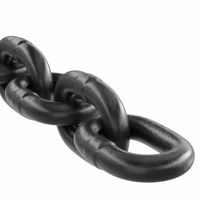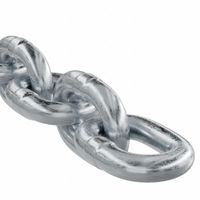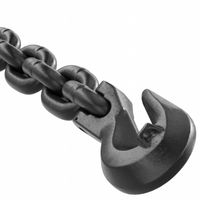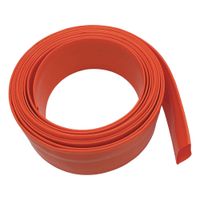Call +(254) 703 030 000 / 751 483 999 / 721 704 777
.....Read More
Frequently Asked Questions
What are the different types of chains used for towing and securing loads?
There are several types of chains used for towing and securing loads, each designed for specific applications and load capacities:
1. **Grade 30 Proof Coil Chain**: This is a general-purpose, low-strength chain made from low-carbon steel. It is commonly used for light-duty applications such as securing loads in non-critical situations.
2. **Grade 43 High-Test Chain**: Made from medium-carbon steel, this chain offers higher strength than Grade 30 and is used for more demanding applications like towing and load binding. It is often used in agriculture and construction.
3. **Grade 70 Transport Chain**: Known as transport or trucker's chain, this is a high-strength, heat-treated carbon steel chain. It is used for securing heavy loads during transport and is commonly seen in the trucking industry.
4. **Grade 80 Alloy Chain**: Made from alloy steel, this chain is designed for heavy-duty lifting and rigging applications. It is heat-treated for high strength and durability, making it suitable for overhead lifting.
5. **Grade 100 Alloy Chain**: Offering even higher strength than Grade 80, this chain is used in demanding lifting and rigging applications. It is also made from alloy steel and is heat-treated for maximum durability.
6. **Grade 120 Alloy Chain**: The strongest of the alloy chains, Grade 120 is used for the most demanding lifting applications. It provides superior strength and wear resistance.
7. **Stainless Steel Chain**: While not as strong as alloy chains, stainless steel chains are used in environments where corrosion resistance is critical, such as marine applications.
8. **Plastic Chain**: Used for lightweight applications, plastic chains are often used for crowd control or decorative purposes rather than load securing.
Each type of chain is selected based on the specific requirements of the towing or securing task, including load weight, environmental conditions, and safety standards.
How do I determine the weight limit for a chain?
To determine the weight limit for a chain, follow these steps:
1. **Identify the Chain Type**: Determine the type of chain you have, such as alloy steel, stainless steel, or galvanized steel, as different materials have different strength properties.
2. **Check Manufacturer Specifications**: Refer to the manufacturer's specifications or product documentation, which typically provide the Working Load Limit (WLL) or Safe Working Load (SWL) for the chain. This is the maximum weight the chain can safely support.
3. **Determine Chain Grade**: Chains are graded based on their strength. Common grades include Grade 30, 43, 70, 80, and 100. Higher grades indicate stronger chains. The grade is often stamped on the chain links.
4. **Measure Chain Size**: Measure the diameter of the chain link. The size, usually in millimeters or inches, affects the chain's strength.
5. **Consult Load Charts**: Use load charts provided by manufacturers or industry standards, which list the WLL for different chain sizes and grades.
6. **Consider Safety Factors**: Apply a safety factor to account for dynamic loads, wear, and environmental conditions. A common safety factor is 4:1, meaning the chain's breaking strength is four times the WLL.
7. **Inspect for Wear and Damage**: Regularly inspect the chain for signs of wear, corrosion, or damage, which can reduce its load capacity.
8. **Compliance with Standards**: Ensure the chain complies with relevant standards such as ASTM, ISO, or OSHA, which provide guidelines for safe use.
9. **Professional Assessment**: For critical applications, consult a professional engineer to assess the chain's suitability for your specific needs.
By following these steps, you can accurately determine the weight limit for a chain and ensure safe usage.
What is the difference between lifting chains and load-securing chains?
Lifting chains and load-securing chains serve distinct purposes and have different characteristics:
1. **Purpose**:
- **Lifting Chains**: These are designed to lift and move loads vertically. They are used in conjunction with lifting equipment like cranes and hoists. Their primary function is to bear the weight of the load during lifting operations.
- **Load-Securing Chains**: These are used to secure loads during transportation, ensuring that the cargo remains stable and does not shift. They are commonly used in trucking, shipping, and rail transport.
2. **Design and Construction**:
- **Lifting Chains**: Made from high-strength alloy steel, lifting chains are engineered to withstand the stresses of lifting heavy loads. They are often heat-treated for added strength and durability. The links are designed to handle tensile forces and are typically more robust.
- **Load-Securing Chains**: These chains are generally made from carbon steel and are not designed to lift loads. They are intended to resist lateral forces and prevent movement. The construction is focused on durability and resistance to environmental factors like corrosion.
3. **Standards and Regulations**:
- **Lifting Chains**: Must comply with strict industry standards and regulations, such as those set by OSHA or ISO, to ensure safety during lifting operations. They are subject to regular inspections and maintenance.
- **Load-Securing Chains**: Governed by different standards, such as those from the Department of Transportation (DOT), focusing on securing loads safely during transit.
4. **Identification**:
- **Lifting Chains**: Often marked with grade and capacity information, indicating their lifting capabilities.
- **Load-Securing Chains**: Typically marked with information relevant to securing, such as working load limit (WLL).
In summary, lifting chains are for vertical lifting, while load-securing chains are for stabilizing loads during transport.
How do I properly secure a load with chains for transport?
To properly secure a load with chains for transport, follow these steps:
1. **Select the Right Chains**: Choose chains with a working load limit (WLL) that matches or exceeds the weight of the load. Grade 70 transport chains are commonly used for securing loads.
2. **Inspect Chains and Equipment**: Check chains, binders, and anchor points for damage, wear, or defects. Replace any compromised equipment.
3. **Position the Load**: Center the load on the trailer to maintain balance and prevent shifting. Ensure the load is stable and evenly distributed.
4. **Anchor Points**: Use designated anchor points on the trailer. These should be rated for the load's weight and positioned to prevent movement.
5. **Chain Placement**: Place chains over the load in a crisscross pattern for stability. Use at least four chains for heavy loads, securing each corner.
6. **Tensioning**: Use chain binders to tighten the chains. Lever binders or ratchet binders can be used, but ensure they are compatible with the chain size. Tighten until the chains are taut but not overstressed.
7. **Check Angles**: Chains should be at a 45-degree angle to the load for optimal security. Adjust as necessary to maintain this angle.
8. **Secure Loose Ends**: Tie down or secure any excess chain to prevent it from flapping during transport.
9. **Double-Check**: Walk around the load to ensure all chains are tight and secure. Recheck after driving a short distance, as loads can settle.
10. **Compliance**: Follow all local regulations and guidelines for load securing, including the number of chains required and specific tie-down methods.
11. **Regular Inspections**: Periodically check the chains and load during transport, especially after sudden stops or sharp turns. Retighten as needed.
What safety precautions should be taken when using chains for rigging?
When using chains for rigging, several safety precautions are essential to ensure safe and effective operations:
1. **Inspection**: Before use, inspect chains for wear, corrosion, cracks, or deformation. Check for stretched links and ensure the chain is free from nicks or gouges.
2. **Load Limits**: Always adhere to the Working Load Limit (WLL) specified by the manufacturer. Never exceed this limit, as it can lead to chain failure.
3. **Proper Sizing**: Use the correct size and grade of chain for the specific load and application. Ensure compatibility with other rigging components.
4. **Avoid Twisting**: Chains should not be twisted or kinked during use, as this can weaken the chain and lead to failure.
5. **Secure Connections**: Ensure all connections, such as hooks and shackles, are properly secured and compatible with the chain size and load.
6. **Angle Considerations**: Be mindful of the angle at which the chain is used. Larger angles can reduce the effective load capacity of the chain.
7. **Environmental Factors**: Consider environmental conditions such as temperature, which can affect the chain's strength. Avoid using chains in corrosive environments unless they are specifically designed for such conditions.
8. **Training**: Ensure all personnel involved in rigging operations are properly trained and understand the risks and procedures associated with using chains.
9. **Avoid Shock Loading**: Do not subject chains to sudden loads or impacts, as this can cause failure.
10. **Storage**: Store chains properly when not in use to prevent damage. Keep them clean and lubricated to prevent rust and corrosion.
11. **Tagging and Documentation**: Maintain proper documentation and tagging of chains to track their usage history and ensure they are fit for use.
By following these precautions, the risk of accidents and equipment failure can be significantly reduced.
Can utility chains be used for overhead lifting?
No, utility chains should not be used for overhead lifting. Utility chains are typically designed for general-purpose applications such as securing loads, towing, or binding, but they lack the necessary specifications and safety features required for overhead lifting tasks. Overhead lifting involves hoisting loads above ground level, which demands equipment that can safely handle the weight and dynamic forces involved.
Utility chains are not manufactured to meet the stringent standards and regulations set for lifting equipment. They often lack the appropriate grade, strength, and construction needed to ensure safety during lifting operations. Using utility chains for overhead lifting can lead to catastrophic failures, resulting in dropped loads, property damage, or even serious injury or death.
For overhead lifting, it is crucial to use chains specifically designed and rated for lifting purposes, such as alloy steel chains that meet the American Society for Testing and Materials (ASTM) standards or other relevant industry standards. These chains are engineered to withstand the stresses of lifting and are marked with their working load limits (WLL), ensuring they are used within safe parameters.
In summary, always use the appropriate lifting chains and equipment that are certified and rated for overhead lifting to ensure safety and compliance with industry standards.
How do protective covers for chains work and when should they be used?
Protective covers for chains, often made from materials like nylon, polyester, or rubber, serve to shield the chain from environmental elements and reduce wear and tear. They work by providing a barrier between the chain and external factors such as dirt, moisture, and UV rays, which can cause rust and corrosion. Additionally, these covers help prevent the chain from scratching or damaging surfaces it comes into contact with, such as painted or delicate finishes.
The covers also reduce friction between the chain and other surfaces, which can prolong the life of both the chain and the surfaces it interacts with. By minimizing direct contact, they help maintain the chain's lubrication, ensuring smoother operation and reducing the need for frequent maintenance.
Protective covers should be used in several scenarios:
1. **Outdoor Use**: When chains are exposed to harsh weather conditions, covers protect against rain, snow, and sun, preventing rust and degradation.
2. **Storage**: During periods of inactivity, covers keep chains clean and free from dust and debris, which can accumulate and cause damage over time.
3. **Transport**: When chains are used for securing loads, covers prevent them from scratching or damaging the items being transported.
4. **High-Friction Environments**: In situations where chains are in constant motion or contact with other surfaces, covers reduce wear and extend the chain's lifespan.
5. **Aesthetic and Safety Concerns**: Covers can improve the appearance of chains and reduce the risk of injury from sharp edges or pinching.
In summary, protective covers for chains are essential for maintaining chain integrity, enhancing safety, and extending the lifespan of both the chain and the surfaces it interacts with. They should be used whenever chains are exposed to potentially damaging conditions or when protection of surrounding surfaces is necessary.



